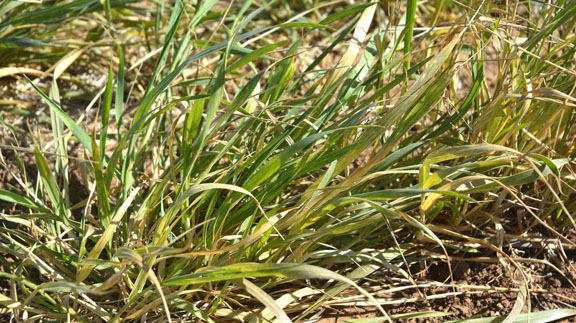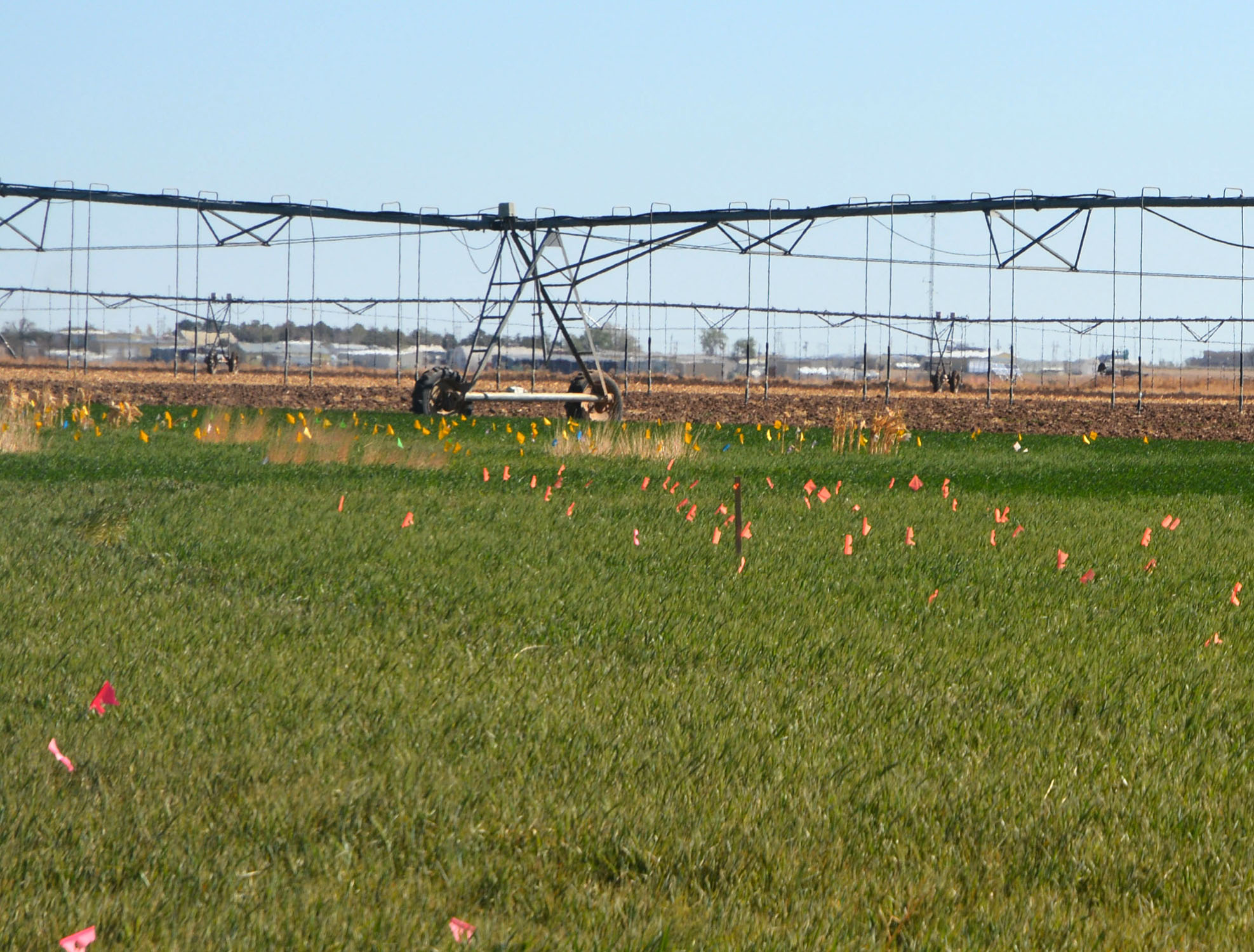Farm & Ranch
Experts: Identification could save producers water, money

By: Kay Ledbetter
Writer: Kay Ledbetter, 806-677-5608, [email protected]
Contacts: Dr. Qingwu Xue, 806-354-5803, [email protected]
Dr. Charlie Rush, 806-354-5804, [email protected]
Dr. Fekede Workneh, 806-354-5815, [email protected]
AMARILLO – As spring growth of wheat begins, Texas A&M AgriLife Research studies indicate now might be the time to determine possible wheat streak mosaic virus infection and future management of the crop.
During the past three years, the AgriLife Research plant pathology and crop physiology programs in Amarillo have concentrated studies on the occurrence of wheat streak mosaic disease and how it impacts a crop’s water-use efficiency. The disease is caused by a virus transmitted by the wheat curl mite.
Knowing that major productivity losses can occur to both grain and forage yields in wheat with this virus, the research studies are trying to determine if the infection can be predicted at the early stages, and at what stages the infection is most damaging.
Both of these projects were partially funded by the U.S. Department of Agriculture’s Ogallala Aquifer Program and reported upon at the program’s recent annual conference in Manhattan, Kansas.
The physiological study by Xue titled “Physiological responses of hard red winter wheat to infection by wheat streak mosaic virus” will appear in Phytopathology, a periodical journal published by American Phytopathological Society.
Dr. Charlie Rush, AgriLife Research plant pathologist, and his team, including Dr. Fekede Workneh, senior r
esearch scientist in plant disease epidemiology, initiated a study to investigate whether the progressive nature of the disease could be exploited and early infections used to predict future impact on grain yield and plant biomass.
As temperatures warm during the next few weeks, symptoms of wheat streak will become more obvious, so growers should be on the lookout, Rush said.
“It is difficult to tell for sure in the field whether a particular symptom is caused by wheat streak or something else, and the only way to know for sure is to take the sample into the plant diagnostic lab and have it tested.” he said.
Barley yellow dwarf, a virus-caused disease transmitted by several different aphid species, and Russian aphids and greenbugs have been widespread this year, and they do cause discrete spots of yellowing wheat. At times these symptoms can easily be confused with wheat streak, even by a trained observer, Rush said.
When a producer is looking at wheat and trying to determine what is causing sick plants, he said uniformly yellowing leaves in a definite pattern, such as yellow stripes or spots, is probably not due to a mite-vectored virus disease such as wheat streak.
But streaks of green and yellow and little yellow flecks on individual leaves, a mosaic pattern, probably indicates its presence, Rush said. Wheat streak often starts at the edges of fields and symptoms spread across the field over time.
“It is important to know the difference between aphid damage and wheat streak because with aphids you can always spray to knock down populations to a manageable level, while with wheat streak, there is little a grower can do after symptoms begin to appear,” he said.
“By that time, the virus has already infected the plants and depending on how widespread the disease is in the field, the only thing the farmer can do is decide on whether or not to keep irrigating.”
If symptoms are widespread across a field in early April, yield potential is very low and additional inputs are questionable, the researchers said. If symptoms don’t begin to show up until early or mid-May, yields will still be reduced compared to a healthy, non-diseased crop, but it won’t be a total loss.
The disease causes root reduction, which significantly impedes soil water uptake, leaving growers uncertain as to when they should continue irrigating or stop and graze the wheat out, Workneh said.
“In order to answer that question, we are currently trying to determine if we can predict the disease early,” he said. “The good thing about this disease is it is progressive over time, and in many cases begins on the edges and progresses into the field. This will help us assess the disease at different severity stages, which could be related to yield and forage biomass.”
Workneh said the results so far are promising.
“We believe we will be able to tell growers that either the disease occurrence is severe and the field may not yield very well or the disease occurrence is not that severe, enabling them to make early decisions on management options including the need for irrigation,” he said.
“But we need to continue the research for several years and include weather data to see how the temperature over the years affects the data,” Workneh said. “It is a good start, but we need to continue the research.”
Dr. Qingwu Xue, AgriLife Research plant physiologist, said his studies concentrated on the timing of the virus infestation and how that affected yield.
“We mechanically infested the wheat plants with the virus at different stages of the wheat,” Xue said. “We inoculated it with the virus at the three-leaf, four-leaf, five-leaf, jointing and booting stages. Then we looked at the physiological responses of wheat plants.
“What we found in our two greenhouse studies is the grain and forage yields can be reduced tremendously when the virus infects the plants at an early stage – the three-leaf to five-leaf stages,” he said. “If you irrigate wheat, then it might not be worth it when the field is infested early.”
Xue said the wheat yields can still be affected if the infestation comes at jointing stage, so spring infestations also can reduce grain yield.
Early wheat streak mosaic virus spread on the greenhouse-inoculated plants resulted in a significant reduction in shoot biomass, root dry weight, tillers, water-use efficiency and yield. The infection did not affect rooting depth but reduced the number of nodal roots, he said.
While the research in both programs will continue, AgriLife Research offers an early disease detection system for producers through a Listserv and website, http://bit.ly/1sVKFfA.
Producers can subscribe and will be notified of the name of the county, types of pathogen found and the discovery date. Additionally, samples of diseased wheat can be submitted to the Plant Diagnostics Lab at the Texas A&M AgriLife Research and Extension Center, 6500 Amarillo Blvd. West in Amarillo for testing.
-30-
Farm & Ranch
Hazards of Backyard Poultry

By Barry Whitworth, DVM
Having backyard poultry is a popular agriculture enterprise. According to the United States Department of Agriculture, 0.8 percent of all households in the United States have chickens. People keep chickens for a variety of reasons with table eggs being one of the more common reasons.
Unfortunately, some of these poultry producers are not aware of the hazards that come with keeping poultry because many times they carry pathogens but appear healthy.
Chickens are carriers of several zoonotic diseases. These are diseases that can be passed from animals to humans. According to a recent survey in Pennsylvania, a majority of backyard poultry producers were aware of the dangers of avian influenza. However, this study also revealed that far fewer producers were aware of the risk of possible exposure to Salmonella and Campylobacter.
The lack of knowledge about the hazards of raising poultry likely contributes to the continued issues of Salmonella outbreaks associated with backyard poultry. In 2023, the Centers for Disease Control and Prevention reported 1,072 illnesses of Salmonella linked to backyard poultry, and 272 of those patients required hospitalization. Oklahoma reported 43 individuals with the disease.
To read more, pick up a copy of the April issue of NTFR magazine. To subscribe by mail, call 940-872-5922.
Farm & Ranch
Ag Elsewhere: Wyoming

By Tressa Lawrence
Babies are tucked away in every nook and cranny. Many ranchers across Wyoming have baby animals popping up all over this time of year.
Farm & Ranch
Ag Elsewhere: Montana

By Lindsey Monk
Another load of grain in to keep feeding the calves until the green grass can really start popping.
-

 Country Lifestyles1 year ago
Country Lifestyles1 year agoScott & Stacey Schumacher: A Growth Mindset
-

 Equine7 months ago
Equine7 months agoThe Will to Win
-

 Country Lifestyles7 years ago
Country Lifestyles7 years agoStyle Your Profile – What your style cowboy hat says about you and new trends in 2017
-

 Country Lifestyles4 years ago
Country Lifestyles4 years agoAmber Crawford, Breakaway Roper
-

 HOME7 years ago
HOME7 years agoGrazing North Texas – Wilman Lovegrass
-

 Country Lifestyles7 years ago
Country Lifestyles7 years agoDecember 2016 Profile, Rusty Riddle – The Riddle Way
-

 Country Lifestyles8 years ago
Country Lifestyles8 years agoJune 2016 Profile – The man behind the mic: Bob Tallman
-

 Outdoor9 years ago
Outdoor9 years agoButtercup or Primrose?








